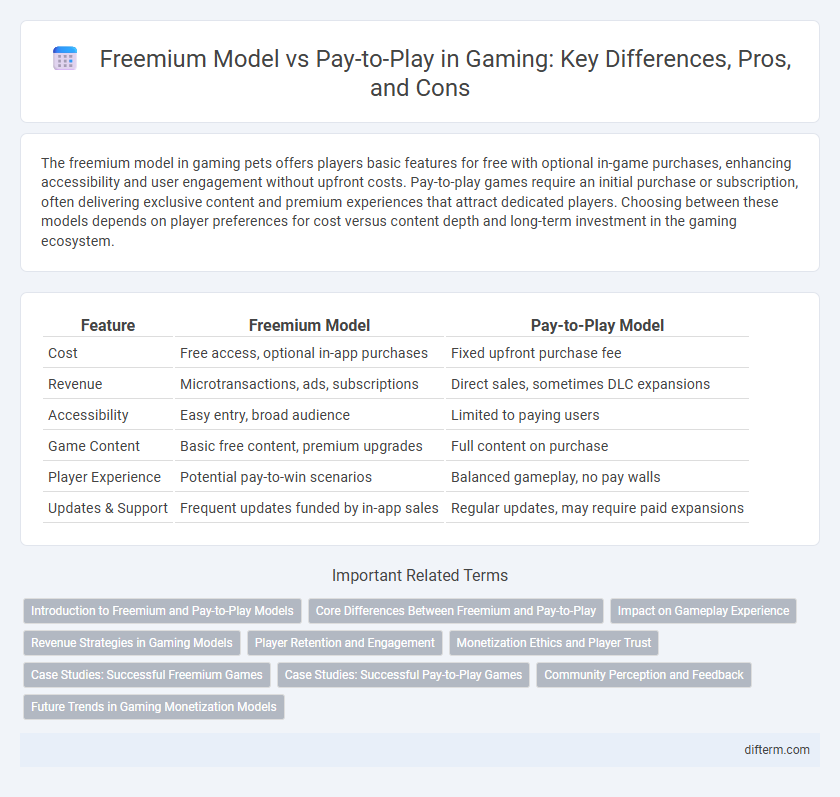The freemium model in gaming pets offers players basic features for free with optional in-game purchases, enhancing accessibility and user engagement without upfront costs. Pay-to-play games require an initial purchase or subscription, often delivering exclusive content and premium experiences that attract dedicated players. Choosing between these models depends on player preferences for cost versus content depth and long-term investment in the gaming ecosystem.
Table of Comparison
| Feature | Freemium Model | Pay-to-Play Model |
|---|---|---|
| Cost | Free access, optional in-app purchases | Fixed upfront purchase fee |
| Revenue | Microtransactions, ads, subscriptions | Direct sales, sometimes DLC expansions |
| Accessibility | Easy entry, broad audience | Limited to paying users |
| Game Content | Basic free content, premium upgrades | Full content on purchase |
| Player Experience | Potential pay-to-win scenarios | Balanced gameplay, no pay walls |
| Updates & Support | Frequent updates funded by in-app sales | Regular updates, may require paid expansions |
Introduction to Freemium and Pay-to-Play Models
Freemium models in gaming offer basic gameplay for free while monetizing through in-app purchases, expansions, or premium features, attracting a broad user base by lowering entry barriers. Pay-to-play models require upfront payment or subscription fees, often providing a complete, ad-free experience with guaranteed content access. Both approaches balance revenue generation and player engagement, influencing game design and marketing strategies in the industry.
Core Differences Between Freemium and Pay-to-Play
The core difference between freemium and pay-to-play gaming models lies in access and monetization strategies. Freemium games offer free initial access with optional in-game purchases or premium upgrades, leveraging microtransactions to generate revenue. Pay-to-play games require upfront payment or subscription, providing full content access without reliance on in-game purchases for progression or competitive advantage.
Impact on Gameplay Experience
The freemium model often enhances accessibility by allowing players to try games without upfront costs but can introduce gameplay imbalances through microtransactions that affect player progression and competitiveness. Pay-to-play games typically offer a more consistent gameplay experience, as all players have equal access to core content without paywalls or in-game purchases impacting fairness. This distinction influences player engagement and satisfaction, with freemium models sometimes generating frustration over perceived pay-to-win mechanics, whereas pay-to-play games emphasize skill and strategy over financial investment.
Revenue Strategies in Gaming Models
Freemium models generate revenue by offering free access with optional in-game purchases, driving higher user engagement and monetization through microtransactions and ads. Pay-to-play relies on upfront payments, ensuring immediate revenue but limiting the player base compared to freemium strategies. Combining subscription services with in-game purchases further diversifies income streams and maximizes lifetime value per user in competitive gaming markets.
Player Retention and Engagement
The freemium model boosts player retention by offering free access with optional in-game purchases, encouraging longer gameplay and higher engagement through ongoing content updates and rewards. Pay-to-play games often see lower initial engagement but attract a dedicated audience willing to invest upfront for premium experiences and exclusive content. Analyzing player data reveals that freemium structures increase active user metrics while pay-to-play titles maintain steady engagement among committed players.
Monetization Ethics and Player Trust
The freemium model often raises ethical concerns as it can exploit player psychology through microtransactions, impacting player trust and satisfaction. Pay-to-play models provide transparent monetization, fostering a straightforward relationship with users by requiring an upfront payment. Balancing monetization ethics with maintaining player trust is crucial for long-term community engagement and sustainable revenue.
Case Studies: Successful Freemium Games
Games like Fortnite and League of Legends demonstrate the success of the freemium model by offering free access while monetizing through in-game purchases and battle passes. Case studies reveal that these games achieve high player retention and revenue by balancing engaging gameplay with optional microtransactions. This approach contrasts with pay-to-play models, which rely on upfront purchases but often display lower long-term engagement.
Case Studies: Successful Pay-to-Play Games
Pay-to-play games like World of Warcraft and The Elder Scrolls Online have demonstrated robust revenue streams through subscription models, attracting dedicated player bases willing to invest for premium content and regular updates. Case studies reveal these titles maintain high user engagement by offering expansive worlds and continuous content expansion, contrasting with freemium games that rely heavily on microtransactions. Data indicates pay-to-play models foster a more stable and predictable income, enabling developers to focus on quality and long-term player satisfaction over aggressive monetization tactics.
Community Perception and Feedback
Community perception of the freemium model often highlights concerns about gameplay fairness and pay-to-win mechanics, affecting player retention and engagement. Pay-to-play games generally receive feedback praising balanced competition and skill-based progression but may face criticism for access barriers due to upfront costs. Player forums and review platforms reveal that transparency and value in monetization significantly influence overall satisfaction across both models.
Future Trends in Gaming Monetization Models
Emerging gaming monetization models increasingly blend freemium and pay-to-play elements, leveraging subscription services and microtransactions to maximize player engagement and revenue generation. Data shows a projected 15% annual growth in in-game purchases within freemium frameworks, driven by personalized content and AI-driven dynamic pricing. Blockchain integration and NFTs are poised to redefine ownership and monetization, creating new economic opportunities beyond traditional pay-to-play structures.
freemium model vs pay-to-play Infographic

 difterm.com
difterm.com